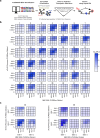Characterizing and engineering post-translational modifications with high-throughput cell-free expression
- PMID: 40764296
- PMCID: PMC12325987
- DOI: 10.1038/s41467-025-60526-6
Characterizing and engineering post-translational modifications with high-throughput cell-free expression
Abstract
Post-translational modifications (PTMs) are important for the stability and function of many therapeutic proteins and peptides. Current methods for studying and engineering PTMs are often limited by low-throughput experimental techniques. Here we describe a generalizable, in vitro workflow coupling cell-free gene expression (CFE) with AlphaLISA for the rapid expression and testing of PTM installing proteins. We apply our workflow to two representative classes of peptide and protein therapeutics: ribosomally synthesized and post-translationally modified peptides (RiPPs) and glycoproteins. First, we demonstrate how our workflow can be used to characterize the binding activity of RiPP recognition elements, an important first step in RiPP biosynthesis, and be integrated into a biodiscovery pipeline for computationally predicted RiPP products. Then, we adapt our workflow to study and engineer oligosaccharyltransferases (OSTs) involved in protein glycan coupling technology, leading to the identification of mutant OSTs and sites within a model vaccine carrier protein that enable high efficiency production of glycosylated proteins. We expect that our workflow will accelerate design-build-test-learn cycles for engineering PTMs.
© 2025. The Author(s).
Conflict of interest statement
Competing interests: M.C.J. and M.P.D. have a financial interest in National Resilience and Gauntlet Bio. M.C.J. also has a financial interest in Stemloop Inc. and Synolo Therapeutics. M.C.J.’s interests are reviewed and managed by Northwestern University and Stanford University in accordance with their competing interest policies. M.P.D.s interests are reviewed and managed by Cornell University. All other authors declare no competing interests.
Figures






Update of
-
Development of cell-free platforms for discovering, characterizing, and engineering post-translational modifications.bioRxiv [Preprint]. 2024 Nov 25:2024.03.25.586624. doi: 10.1101/2024.03.25.586624. bioRxiv. 2024. Update in: Nat Commun. 2025 Aug 5;16(1):7215. doi: 10.1038/s41467-025-60526-6. PMID: 39651187 Free PMC article. Updated. Preprint.
References
-
- Anselmo, A. C., Gokarn, Y. & Mitragotri, S. Non-invasive delivery strategies for biologics. Nat. Rev. Drug Discov.18, 19–40 (2019). - PubMed
-
- Bray, G. et al. A multicenter study of recombinant factor VIII (recombinate): safety, efficacy, and inhibitor risk in previously untreated patients with hemophilia A. The recombinate study group. Blood83, 2428–2435 (1994). - PubMed
-
- Roth, D. A. et al. Human recombinant factor IX: safety and efficacy studies in hemophilia B patients previously treated with plasma-derived factor IX concentrates. Blood98, 3600–3606 (2001). - PubMed
-
- Crosnier, J. et al. Randomised placebo-controlled trial of hepatitis B surface antigen vaccine in French haemodialysis units: I, medical staff. Lancet317, 455–459 (1981). - PubMed
MeSH terms
Substances
Grants and funding
- HDTRA1-20-1-0004/United States Department of Defense | Defense Threat Reduction Agency (DTRA)
- MFE-176575/Gouvernement du Canada | Canadian Institutes of Health Research (Instituts de Recherche en Santé du Canada)
- W911NF-23-2-0039/United States Department of Defense | Defense Advanced Research Projects Agency (DARPA)
- 1U19AI142780-01/Foundation for the National Institutes of Health (Foundation for the National Institutes of Health, Inc.)
- U19 AI142780/AI/NIAID NIH HHS/United States
LinkOut - more resources
Full Text Sources
Miscellaneous

